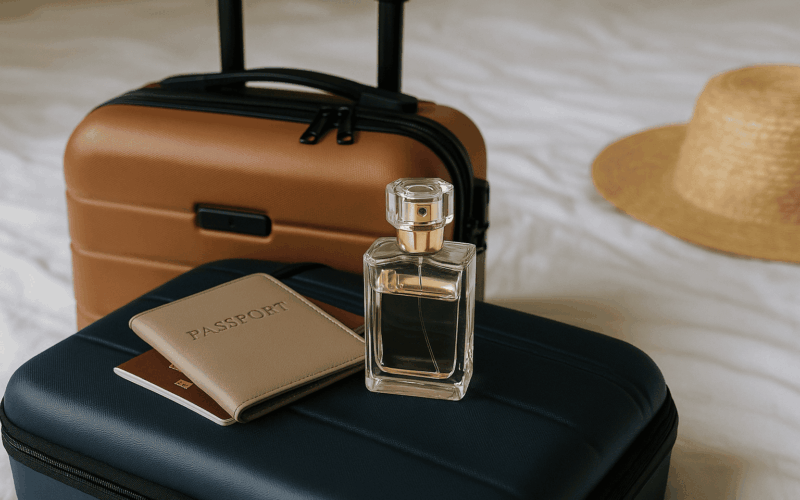A scent can instantly set the right mood: a morning burst of citrus before a business meeting, a drop of resin for an evening walk in a new city. When you’re far from home, having your favorite perfume with you offers a sense of continuity and confidence. But air pressure fluctuations, ruthless baggage handlers, and tropical heat can reduce even the most carefully crafted scent to a faint whisper—or worse, a shattered bottle.
Preserving perfume while traveling isn’t just an aesthetic concern—it’s about protecting your investment. Niche perfumes are costly, and rare limited editions can be irreplaceable. To make sure your fragrance smells as the perfumer intended, you need to understand the chemistry of the liquid, the physics of packaging, and the rules of transport. Below are six in-depth sections to help turn any journey into a safe olfactory voyage.
Choosing the bottle: size, material, seal
The first step is deciding how much you actually need. Most travelers overestimate usage: 5 ml of perfume can last a two-week trip with moderate application. Miniatures save space and reduce the risk of loss in case of leakage. For frequent flyers, it’s worth investing in a travel spray made of aluminum or stainless steel—lightweight, smudge-resistant, and drop-proof.
Material matters. Thin glass looks elegant but is fragile, while plastic is more durable but may react with complex formulas. The best compromise is thick-walled laboratory-grade glass with a screw-on cap and silicone gasket. This setup can withstand up to 1.5 atm of pressure, like that in an airplane cargo hold.
Don’t forget about a pressure-release valve: some luxury travel cases feature a discreet metal insert under the cap that equalizes pressure and prevents a post-landing “pop.” Make sure the spray tube doesn’t reach all the way to the bottom—this reduces air intake and foaming when tilted.
Preparing your perfume: decanting and dosing
Decanting properly is half the success. Use a decanting syringe with a stainless steel needle: the thin wall won’t scratch glass or build static, which helps prevent oxidation. Rinse the syringe with 96° alcohol and let it evaporate completely before use to avoid altering the fragrance’s structure. Wear warm gloves to avoid warming the bottle with your hands.
Concentration matters. If you’re traveling with extrait, take no more than 3 ml: its high oil content makes it thick, and shaking can create bubbles that may push liquid through micro-cracks. For eau de toilette, a 10 ml atomizer is safe—its alcohol base evaporates more easily but tolerates heat better.
Avoid storing the original bottle without a cap: evaporation accelerates even at home, and high hotel humidity can introduce water into the formula. If unsure, refrigerate the remaining perfume at +6°C until you return. Cold slows oxidation without crystallizing aromatic molecules.
Carry-on and checked luggage: security and customs
International regulations allow up to 100 ml of liquids in carry-on baggage, packed in a 1-liter clear zip bag. But seasoned travelers know extra tips that save time and stress:
- Lay bottles horizontally to prevent spray tubes from touching liquid during takeoff
- Place them near the bag’s edge for easier inspection
- Carry a receipt or purchase screenshot: some customs officers (especially in Asia) may ask for proof of authenticity
If you’re checking your perfume, wrap it in a thick cotton sock and place it inside a shoe—the foam sole cushions shock. The closer the bottle is to the center of your suitcase, the less it suffers from handling impact. Note: IATA rules allow up to 500 ml of perfume in checked bags, provided total alcohol per passenger doesn’t exceed two liters.
Protecting against heat, light, and pressure
Heat destroys top notes quickly, and UV light oxidizes citrus accords in hours. Store decants in an insulated insulin case, which maintains +8…+18°C for up to 10 hours without an ice pack. For tropical layovers, include a thin gel cold pack wrapped in flannel—avoid dropping below +4°C to prevent essential oils from precipitating.
For flights and high altitudes, use simple masking tape. Wrap it tightly around the sprayer and neck—this prevents leakage even at 0.7 atm. An aluminum lipstick-sized cache tube offers added light protection and can hold two 3 ml rollers inside.
Be mindful of humidity: in the tropics, tiny pores in the spray mechanism may absorb moisture. After a hotel shower, dry the bottle thoroughly and let it sit under air conditioning for five minutes before packing it away.
On-the-go care: keeping your scent lasting
Even perfectly packed perfume fades faster if your skin is dehydrated from flights. Drink plenty of water and apply unscented lotion 15 minutes before spraying. In strong vacation sun, fragrance evaporates more quickly, so use an oil-based rollerball perfume for precise reapplication on pulse points.
Unexpected scenario—delayed luggage. Keep a few branded testers or samples in your carry-on: if compensation is needed, it’s easier to prove the value of a lost bottle. If your checked perfume arrives but leaked, dab the bottle with rice paper and inspect the seal—sometimes a quick twist with a cross-head screwdriver is all it takes to secure it.
Even after a safe journey, your scent might seem “tired.” Let the perfume rest in a dark cabinet for at least two days before wearing it again—this allows the alcohol phase to stabilize. Learn more about expiration and perfume freshness in our article “Perfume expiration: myths, facts, and when it’s time to let go”
Questions and answers
Decant a portion into a travel spray for your carry-on, and pack the main bottle in checked luggage. No declaration is needed if your total alcohol is under two liters.
Better not: constant warmth from electronics can heat the perfume, accelerate oxidation, and increase internal pressure.
Remove affected clothes immediately, rinse with cold water (no soap), and air dry. Perfume oils “lock in” with heat, and hot washing may leave a permanent scent trace.

